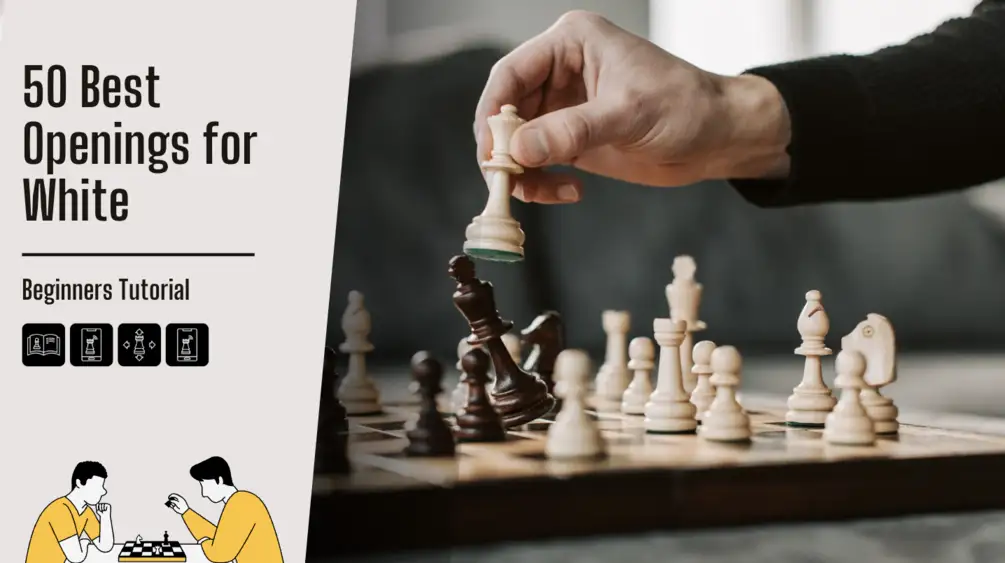The first move in chess says a lot about your style. Do you like open fights, quiet buildup, or long-term pressure? As White, you have the privilege of starting first — and that means you can choose the direction of the entire game.
In this guide, we’ll explore 50 of the best openings for White, from classical choices like the Ruy Lopez and Queen’s Gambit to flexible systems such as the London or King’s Indian Attack. Each section explains, in simple terms, what White should do, not just what to memorize.
Whether you’re a beginner trying to survive the opening or an improving player looking to control the game, these ideas will help you understand the why behind every move. The goal isn’t to learn every variation, but to grasp the plans that make each opening powerful.
- King’s Pawn Opening (1.e4).
The idea is fast central control and piece activity. Main continuations: 1…e5, the Open Games, or Sicilian 1…c5. Typical plan. develop knights to f3 and c3, bishops to c4 or b5, castle kingside, then play d4 to open the center or prepare a kingside attack.
- Queen’s Pawn Opening (1.d4).
Aim for a solid, lasting central presence. Common replies are 1…d5 or Indian defenses (1…Nf6). Typical plan. build with c4, Nc3, and develop bishops, decide between queen’s gambit structures or transpositions, aim for central breaks with e4 or c5 depending on the setup.
- English Opening (1.c4).
A flank opening that fights for d5 and flexible center control. Main ideas. transpose to reversed Sicilian or Queen’s Pawn setups. Typical plan. fianchetto the king’s bishop with g3 and Bg2 or play Nc3 and d4 later to seize central space while keeping options open.
- Reti Opening (1.Nf3).
A flexible, hypermodern start that delays central pawns. Common patterns. transpose to c4 or d4 systems or to king’s pawn lines. Typical plan. develop Nc3, g3 and Bg2, control central squares from afar, and choose a timely d4 or c4 push based on Black’s setup.
- Ruy Lopez / Spanish (1.e4 e5 2.Nf3 Nc6 3.Bb5).
Pressure Black’s knight to weaken the e5 pawn and gain long-term positional play. Key lines. Closed Ruy Lopez with …a6 and …Be7. Typical plan. castle, play d4 or Re1 and expand in the center, slowly improve pieces and prepare pawn breaks like c3-d4 or f4 in sharper lines.
- Italian Game (1.e4 e5 2.Nf3 Nc6 3.Bc4).
Direct piece play aimed at f7 and quick development. Main branches. Giuoco Piano and Evans Gambit if sharper play is wanted. Typical plan. castle early, play d3 then c3 and d4 for central expansion, or open lines quickly with tactical moves in aggressive continuations.
- Scotch Game (1.e4 e5 2.Nf3 Nc6 3.d4).
Open the center quickly to exploit lead in development. Main idea. exchange on d4 and fight for rapid piece activity. Typical plan. recapture with the queen or knight, develop bishops, bring rooks to the center and use open files to pressure Black before they finish development.
- Four Knights Game (1.e4 e5 2.Nf3 Nc6 3.Nc3 Nf6).
Symmetrical development and simple plans. Key themes. quiet piece play, early castling, and central control. Typical plan. finish development with d4 or d3 depending on circumstances, avoid early tactical risks, then expand in the center or on the kingside depending on pawn structure.
- Bishop’s Opening (1.e4 e5 2.Bc4).
Immediate pressure and flexible development aiming at f7. Main continuations. quiet lines that transpose to Italian or sharper gambits if Black plays carelessly. Typical plan. develop knights, castle quickly, play d3 and then c3-d4 or launch kingside play with Ng5 in aggressive lines.
- Vienna Game (1.e4 e5 2.Nc3).
Keeps options open with possibilities for f4 or later d4. Main ideas. transposes to King’s Gambit-like attacks or quiet setups. Typical plan. play f4 in aggressive lines for kingside attacks, or play d3 and g3 for a gradual buildup, developing bishops to c4 or g2.
- King’s Gambit (1.e4 e5 2.f4).
Pawn sacrifice to open lines and speed up development. Key variations. Accepted 2…exf4 or declined with …d5. Typical plan. rapid piece development, castle, and use open f-file and kingside initiative to attack Black’s uncastled king or undermine their hold on the extra pawn.
- Queen’s Gambit (1.d4 d5 2.c4).
Offer the c-pawn to undermine Black’s center and gain long-term control. Main replies. Accepted (2…dxc4) or Declined (…e6 or …c6). Typical plan. recapture center with e4 or play Nc3 and Bg5, then aim for central majority, piece activity and minority attacks in some structures.
- London System (1.d4 then Bf4).
Solid, easy-to-learn setup with minimal theory. Core idea. build a compact formation with Nf3, e3, c3 and Bf4. Typical plan. castle kingside, play for e4 or c4 breaks depending on Black’s layout, keep pieces harmonized and exploit targets once Black overextends.
- Colle System (1.d4 d5 2.Nf3 Nf6 3.e3).
A reliable buildup aiming for an e4 breakthrough. Main structure. maintain pawn chain d4-e3 and develop normally. Typical plan. prepare Nd2 and e4, then use opened lines to activate bishops and rooks. Good choice versus many Black setups.
- Torre Attack (1.d4 Nf6 2.Nf3 e6 3.Bg5).
Pin and provoke weaknesses with an easy development plan. Transpositions. can arise against various Black move orders. Typical plan. develop the queen’s knight to d2 or c3, castle, play c3 and e3, and use the pin or kingside expansion to create play against Black’s king.
- Catalan Opening (1.d4 Nf6 2.c4 e6 3.g3).
Fianchetto the bishop to pressure the long diagonal while keeping a solid center. Main idea. combine Queen’s Gambit structures with a powerful Bg2. Typical plan. play Nc3, Bg2 and castle, then apply pressure to d5 or b7 and use long-term pressure on Black’s queenside and center.
- King’s Indian Attack (setup: Nf3, g3, Bg2, d3, e4).
A universal attacking system with clear kingside plans. Typical vs many Black setups. castle kingside and prepare pawn storm or central breaks. Typical plan. play for e4 and f4, then advance on the kingside with g4/h4 in attacking lines or use the center to open files.
- Larsen’s Opening (1.b3).
Prepare to fianchetto the queen’s bishop and challenge the center from the flank. Main idea. flexible, less theoretical choice. Typical plan. play Bb2, control central squares like e5 and d4, develop knights to c3 and f3, and aim for pawn breaks or pressure along the long diagonal.
- Bird’s Opening (1.f4).
Gain kingside space and aim for central control with f-pawn support. Main ideas. Dutch-like structures and attacking chances. Typical plan. develop Nf3, g3 or e3 depending on setup, play d3 then e4 or push for kingside activity; be mindful of king safety and weak e1–h4 squares.
- Polish / Sokolsky Opening (1.b4).
Seize queenside space and activate the b-file bishop early. Main idea. surprise weapon that creates imbalance. Typical plan. follow up with Bb2, play c4 or a3 as needed, develop knights and contest the center from the wing rather than mirroring classical setups.
- Open Sicilian plan (after 1.e4 c5 then 2.Nf3 and 3.d4).
Open the center to generate dynamic piece play against Black’s wing pawn. Main lines. many Sicilian subvariations arise. Typical plan. recapture with the knight, develop rapidly, castle, use half-open d- and f-files for rooks and launch kingside or queenside attacks depending on the variation.
- Closed Sicilian (1.e4 c5 2.Nc3).
Keep the center closed and build a slow kingside attack. Main idea. avoid immediate central exchanges. Typical plan. fianchetto or play g3/f4 to expand on the kingside, develop bishops behind the pawn chain, and prepare a pawn storm while Black typically plays on the queenside.
- Grand Prix Attack (vs Sicilian, e.g., 1.e4 c5 2.Nc3 Nc6 3.f4).
A direct and straightforward attacking setup against the Sicilian. Main idea. rapid kingside pawn advances. Typical plan. develop Nf3, play Bc4 or d3, castle short and push f5 or g4 to open lines toward Black’s king and exploit quick attacking chances.
- Smith-Morra Gambit (1.e4 c5 2.d4 cxd4 3.c3).
Sacrifice a pawn for rapid development and open lines against Black’s setup. Main idea. active minor pieces and lead in development. Typical plan. recapture with c3, develop knights and bishops aggressively, castle, and use open files and tempo to trouble Black before they consolidate the extra pawn.
- Queen’s Gambit Exchange (1.d4 d5 2.c4 e6 3.cxd5).
Simplify the center early and target structural imbalances. Main idea. trade to create isolated or minority structures you can exploit. Typical plan. after exchanges. develop quickly, target backward or isolated pawns, use rooks on open files and aim to convert small structural advantages into an endgame edge.
- Trompowsky Attack (1.d4 Nf6 2.Bg5).
Idea: Immediately challenge Black’s knight and avoid heavy theory. Main replies include …Ne4 or …d5. Typical plan: exchange on f6 or pin the knight, develop with Nf3, e3, c3, castle, then target weakened dark squares and aim for a quick kingside initiative or central breaks with e4.
- Veresov Attack (1.d4 Nf6 2.Nc3 d5 3.Bg5).
Idea: Rapid piece play and early bishop sortie to g5. Key continuations: either transposes to Queen’s Pawn systems or independent lines after …Bf5 or …Ne4. Typical plan: develop queenside pieces, play e3 and Bd3, castle, and prepare e4 or f3 to gain central space and attacking chances.
- Jobava London (1.d4 Nf6 2.Nc3 d5 3.Bf4).
Idea: Hybrid of Veresov and London for fast piece activity and tactical motifs. Main lines. Black can play …Bf5 or …c5. Typical plan: quickly develop knights, play e3 and Qd2, castle (often long), and launch kingside play with e4/f3/g4 or tactical thrusts against Black’s center.
- Colle-Zukertort (Colle with b3) (1.d4 d5 2.Nf3 Nf6 3.e3 e6 4.Bd3 c5 5.b3).
Idea: Colle setup but fianchetto queenside bishop for extra pressure. Main ideas: compact center and kingside plans. Typical plan: castle, play Bb2, prepare c4 or e4, and use piece coordination and the long diagonal to pressure Black’s queenside and central structure.
- Stonewall Attack (system: d4, e3, f4, Bd3, Nf3).
Idea: Create a solid pawn wedge on c3-d4-e3-f4 for a kingside assault. Common against various defenses. Typical plan: build the brick of pawns, castle short, then push g4-h4 or break with e4 depending on Black’s setup, using strong outposts on e5 and attacking along the kingside.
- Blackmar–Diemer Gambit (1.d4 d5 2.e4).
Idea: Sacrifice a pawn for rapid development and attacking chances. Main reply: 2…dxe4, then 3.Nc3 or 3.f3. Typical plan: recapture or sacrifice further to open lines, develop quickly with Bc4 and Qe2, castle and launch immediate kingside attacks before Black finishes development.
- Alapin Sicilian (1.e4 c5 2.c3).
Idea: Avoid mainline Sicilian theory and aim for a calm center with d4 under better conditions. Main continuations: 2…d5 or 2…Nf6. Typical plan: play d4 to open the center when prepared, develop knights to f3 and c3, bishops behind the pawn chain, and use more controlled maneuvering than sharp Sicilian battles.
- Rossolimo Attack (1.e4 c5 2.Nf3 Nc6 3.Bb5).
Idea: Fight typical Sicilian defenses by exchanging or pressuring Black’s knight and avoiding heavy Najdorf theory. Main lines: 3…g6 or 3…e6. Typical plan: castle, maintain tension on the c6 knight, play for central breaks with d4 or slow buildup with c3 and d4 depending on Black’s reply.
- Moscow Variation (Sicilian) (1.e4 c5 2.Nf3 d6 3.Bb5+).
Idea: Simplify via an early check to avoid deep Najdorf theory and create different pawn structures. Main replies: 3…Bd7 or 3…Nc6. Typical plan: after exchanges, develop solidly with d4, Nc3, and castle, aiming for piece activity rather than wild Sicilian complications.
- Panov–Botvinnik Attack (against Caro–Kann) (1.e4 c6 2.d4 d5 3.exd5 cxd5 4.c4).
Idea: Turn the Caro–Kann into an isolated-pawn or IQP structure to maximize piece activity. Typical plan: develop pieces to active squares, use the c-file and central tension, attack the d5 pawn and use rooks on open files; aim for dynamic piece play rather than slow maneuvering.
- Caro–Kann Advance Variation (1.e4 c6 2.d4 d5 3.e5).
Idea: Grab space with e5 and restrict Black’s piece play. Main responses: …Bf5 or …c5 breaks. Typical plan: consolidate with c3, Nf3, Bd3, and aim for kingside play or a central break with f4/f5; be ready to support the advanced pawn chain and restrict Black’s counterplay.
- French Exchange Variation (1.e4 e6 2.d4 d5 3.exd5).
Idea: Simplify the center early to reach symmetrical but slightly freer play for White. Typical plan: develop smoothly, target small structural differences (like backward pawns), use space advantage and piece activity to press for early imbalances and favorable endgames.
- Evans Gambit (1.e4 e5 2.Nf3 Nc6 3.Bc4 Bc5 4.b4).
Idea: Sacrifice a wing pawn to rapidly open lines and accelerate development. Main idea: 4…Bxb4 5.c3. Typical plan: recover tempo, bring knights and bishops to aggressive squares, castle quickly and use open files and diagonals to launch a direct attack on Black’s king while Black struggles to consolidate.
- Scotch Gambit (1.e4 e5 2.Nf3 Nc6 3.d4 exd4 4.Bc4).
Idea: Sacrifice or pressure to open the center and exploit lead in development. Main lines can transpose to Scotch or Italian motifs. Typical plan: bring pieces into the center quickly, castle, and use rooks on open files and bishops on long diagonals to pressure Black before they complete development.
- Vienna Gambit (1.e4 e5 2.Nc3 Nf6 3.f4).
Idea: A King’s Gambit–like thrust from the Vienna to seize initiative. Main replies include 3…d5. Typical plan: open lines with f4, develop rapidly with Nf3, Bc4, castle, and push for kingside attacking chances using the f-file and central tension.
- Mieses Opening (1.d3).
Idea: Ultra-flexible, non-committal start that avoids theory and prepares a calm setup. Main continuations: often transpose to King’s Indian Attack structures or quiet d4/c4 systems. Typical plan: develop Nf3, g3, Bg2, castle, then push for central advances like e4 or c4 when the position is right.
- English Opening – Botvinnik System (1.c4 Nf6 2.Nc3 e5 3.g3).
Idea: A sharp English setup with central tension and kingside fianchetto. Main themes: pawn wedge in the center and piece play on both wings. Typical plan: play Bg2, Nf3, d3 or d4 depending on Black, then prepare minority or central breaks and agresive kingside play if space and timing permit.
- Four Pawns Attack (against King’s Indian) (1.d4 Nf6 2.c4 g6 3.Nc3 Bg7 4.e4 d6 4.f4).
Idea: Gain maximal central space by advancing four central pawns. Main reply by Black is counterplay against the center. Typical plan: maintain central pawn chain, develop quickly, use the space to restrict Black’s pieces, but be ready to defend the center and avoid overextension when Black counterattacks.
- Giuoco Pianissimo (quiet Italian), (1.e4 e5 2.Nf3 Nc6 3.Bc4 Bc5 4.d3)
Idea: Slow, maneuvering approach inside the Italian family that emphasizes small improvements and piece harmony. Main moves: quiet development with d3 and Re1. Typical plan: build a steady center with c3 and d4 at the right moment, reposition knights and bishops, then prepare a timely breakthrough or kingside expansion.
- Austrian Attack (against Pirc/Modern) (1.e4 d6 2.d4 Nf6 3.Nc3 g6 4.f4).
Idea: Direct, aggressive setup versus hypermodern defenses to seize space and launch kingside attacks. Typical plan: develop rapidly with Nf3, Be3, Qd2, castle (often long), and push g4/h4 or f5 to open lines against Black’s king and exploit Black’s delayed central control.
- Napoleon Opening / Wayward Queen (1.e4 e5 2.Qf3).
Idea: Early queen move that pressures f7 but can be risky due to loss of tempo. Typical plan: if Black misplays, continue with active piece play; otherwise, aim to rapidly develop, retreat the queen if attacked, and avoid getting tangled in tactics. Useful as surprise weapon at club level.
- King’s Fianchetto Reversed English (1.g3 then 2.Bg2 and 3.c4).
Idea: Flexible fianchetto setup that can transpose to the English, Reti, or Catalan with reversed colors. Typical plan: complete kingside fianchetto, play Nc3 and d4 or c4 depending on Black, then use long diagonal pressure and central breaks to create targets.
- Trompowsky–Veresov hybrids (various move orders combining Bg5 and Nc3).
Idea: Mix the early Bg5 and Nc3 ideas to keep Black guessing and reach dynamic middlegames. Typical plan: develop actively, choose between quick e4 or f3 setups, castle, and use piece pressure on f6/e5 squares to create tactical chances and long-term pressure.
- Modern Benoni Attack setups for White (1.d4 Nf6 2.c4 c5 3.d5).
Idea: Seize space with an early d5 and aim for a kingside/central leverage against Black’s pawn breaks. Typical plan: support the d5 pawn with e4/c4, develop Bg5/Bf4, and prepare kingside or central expansions while preventing Black’s standard …b5 or …e6 counterplay.
- Anti–Slav and QGD Systems (1.d4 d5, various early c3, Nc3 setups).
Idea: Flexible choices inside Queen’s Gambit and Slav territory that avoid heavy theory—e.g., the Meran, Anti-Slav with 3.Nc3 or 3.c3. Typical plan: solid development with c3 and Nc3, aim for central breaks with e4 or b4 depending on structure, and play for long-term piece activity and structural targets.
Openings aren’t just about memorizing moves. They’re about understanding plans. Every pawn move shapes the battlefield. Every piece placement reveals a story. Once you understand what White is trying to achieve in each of these openings, you’ll stop fearing preparation — and start playing chess with purpose.
If you’re ready to go deeper, try focusing on 3–5 openings that fit your style. Experiment, analyze, and refine them over time. Remember: openings get you to the middlegame — but understanding gets you to victory.

I’m Xuan Binh, the founder of Attacking Chess, and the Deputy Head of Communications at the Vietnam Chess Federation (VCF). My chess.com and lichess rating is above 2300. Send me a challenge or message via Lichess. Follow me on Twitter (X) or Facebook.

